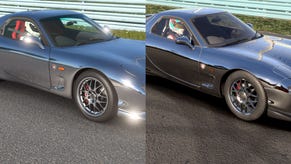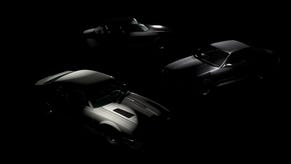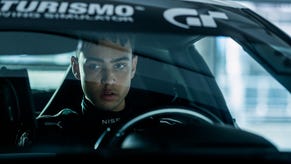Gran Turismo 7: Polyphony Digital delivers the most comprehensive PS5 Pro upgrade we've seen
8K, more RT, better VR, new image quality options and faster frame-rates.
Gran Turismo 7 remains one of the best-looking games this generation, with remarkably high-quality materials, lighting and visual design. The original PS5 release had its limitations though, with limited RT deployment and VR relying on asychronous time warp to the detriment of motion clarity. With the PS5 Pro, there's clearly plenty of potential to deploy the extra horsepower, RT acceleration and PSSR in new and interesting ways. Happily, developer Polyphony Digital has implemented basically everything on our wish list and more in one of the best PS5 Pro patches we've seen yet. Buckle up, this is going to be good!
In typical Polyphony style, the new tech has been added as optional features, allowing you a great degree of control over the game's presentation. At the bottom of options menu, for instance, you'll spot three new settings: 8K support, VR reprojection and PSSR.
The graphics priority setting is also different, with the "prefer RT/resolution" mode now providing RT during gameplay rather than just in replays and photo mode. That means that car surfaces show self reflections, world reflections, lights and other cars, replacing the earlier (still excellent but limited) cubemaps. Reflections now more accurately correspond to the world around you and update more frequently. There are still a few limitations - trees, for example, look simplified in the game's BVH structure - but the aggressive roughness cut-off means that even matte surfaces can produce realistic reflections, which makes interiors look incredible.
 Gran Turismo 7: PS5 Pro Tech Review - Upgraded RT, 120Hz Support, PSVR2 + 8K - The Complete Analysis
Gran Turismo 7: PS5 Pro Tech Review - Upgraded RT, 120Hz Support, PSVR2 + 8K - The Complete Analysis
Gran Turismo 7 also benefits from PSSR, which is an optional setting as mentioned earlier. When used, the internal resolution drops to as low as 1080p with a 4K output resolution, versus a native 4K target with PSSR disabled and the default TAA active. You can use in-game RT with or without PSSR, but RT features in the cockpit view are only active with PSSR enabled.
Given this information, you'd expect that the PSSR view would be inferior to the native 4K presentation - and that's indeed the case. However, the gap between the two is smaller than I expected, with just a few noticeable issues differentiating the two possibilities. First, thin objects can exhibit additional shimmering and noise, such as trackside crash fences, and second, artefacts can appear in certain scenarios. For example, I noticed noisy, flickering taillights with PSSR and RT enabled on a Toyota Supra.
Still, PSSR looks good in most scenarios, so whether or not you'll want to use it is dictated by whether you're interested in cockpit RT or not - or whether you have an 8K display, as that's another feature tied to a PSSR requirement. We don't have any way to capture 8K with display stream compression (DSC) from the PS5 at present, and few people even have 8K displays anyway, but it is a pretty cool future-looking option that's in line with Polyphony's previous work supporting 1080i on PS2 and 1080p on PS3.
Circling back to the performance preferences, the frame-rate option removes RT, reduces the resolution and targets higher frame-rates as you'd expect. Its use mainly makes sense for 120Hz displays, which we'll cover in a moment.
Before moving on, it's worth underlining how much the new RT features elevate the presentation, with both RT in gameplay and in 60fps replays. This is a huge deal and delivers exactly what I wanted from the original release. PSSR, on the other hand, is good in GT7 but I still think the higher-res TAA option looks best. I don't often use the cockpit view personally, so losing RT in that view is a small sacrifice for me.
The one mode where the cockpit is crucial is VR. Gran Turismo 7 has long been the "killer app" for PSVR2, and that remains true today - especially if you have a racing wheel too. The experience is nearly unrivalled in terms of immersion. I didn't expect Polyphony to upgrade the VR mode for PS5 Pro, but the VR reprojection feature is actually one of the best additions of this patch, largely solving the motion clarity issues I had with the original version.


On a base PS5, GT7 runs in VR at 60fps, with asynchronous timewarp interpolating player head movement up to 120fps. Looking around feels smooth, but everything else in the world updates at half-rate, giving a double image effect on all 3D elements. It's hard to explain, but it's like running a 60fps game in a 120Hz container on a CRT or other low-persistence display.
On PS5 Pro, the reprojection option fixes this almost entirely. Motion instantly feels super crisp, the double image effect is gone and nearly all remaining blur is addressed. The difference in clarity is profound, and actual image quality appears higher too with a sharper and more detailed appearance to the eye.
This is effectively Sony's take on asynchronous spacewarp, which unlike timewarp applies to animation, camera and head translation alike. Think of it like frame generation, but geared to VR - the game is generating new frames based on predictions. There's no real information out there about how Sony's implementation works - does it use machine learning? Would it work on a base PS5? - but the effects are exceptional, with only a few minor caveats. For example, sometimes text can appear distorted, or you can get visual anomalies when objects pass behind transparent surfaces like fences, but this is still a huge win given the massive boost in quality and motion clarity.

With the new features discussed, it's time to talk performance. The number of performance-affecting options in the new patch means there are myriad permutations to test beyond the 60fps and 120fps target frame-rate.
When playing with RT enabled or at 8K, the game outputs at 60Hz with a 60fps maximum frame-rate. It's almost always a locked 60fps, even in the 8K mode, but it's possible to see drops in very select scenarios - eg watching a replay of a full standing start in the wet. At worst, 8K mode can drop into the 50s during gameplay, but you're still within range of VRR to make these drops less noticeable. Given that the internal resolution is 4K, that's pretty impressive. The cinematic angles offered in replays tend to run worse than the usual chase, bumper or cockpit cameras, with PSSR tending to offer better performance here.


When running in the 120fps mode, RT is disabled entirely and both PSSR and TAA hit the 120fps target most of the time. This makes for extremely smooth gameplay, especially with VRRR enabled. A rainy track can still result in frame-rate drops, with native 4K actually running faster than PSSR due to the latter tech's fixed ~2ms cost per frame. Therefore, I suggest disabling PSSR entirely in 120fps mode.
All things considered, this is one of the best PS5 Pro patches we've seen thus far, with basically every feature of the new console fully utilised: extra RT capability, new image quality options, higher performance, VR improvements and even 8K support. The number of options is extensive, far from being the "one mode experience" promised by Mark Cerny, but I think it's the right move as this level of granularity fits right in with the ethos driving the series.



-2-18-screenshot.png?width=291&height=164&fit=crop&quality=80&format=jpg&auto=webp)





